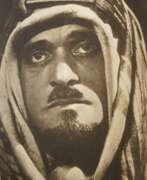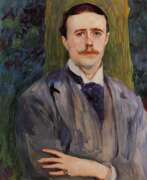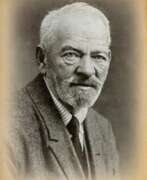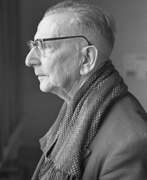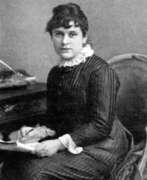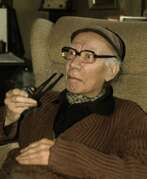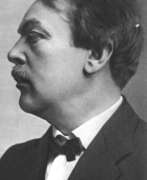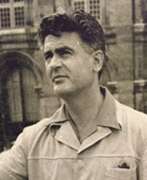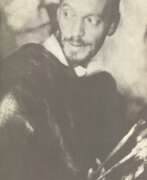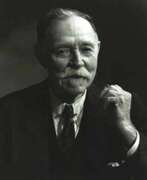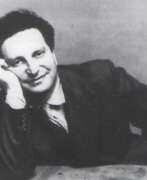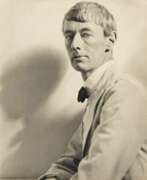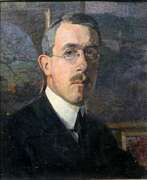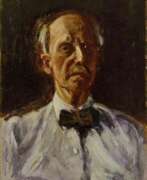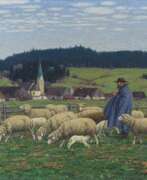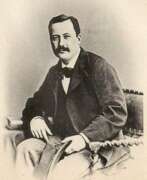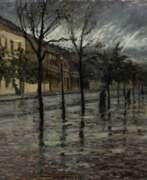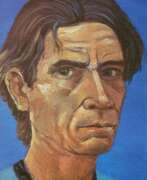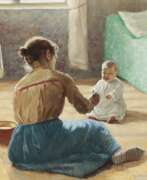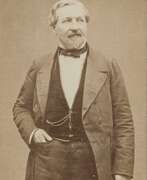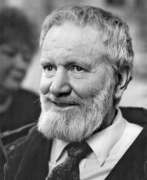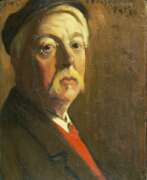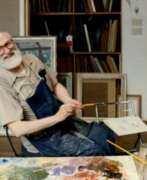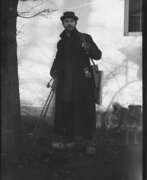Writers Impressionism
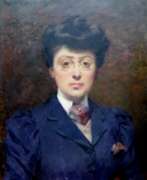

Louise Abbéma was a French painter, sculptor, and designer, celebrated for her work during the Belle Époque. Born in Étampes in 1853 into an affluent Parisian family, she became well known for her portraits, particularly of the famous actress Sarah Bernhardt, and for decorative panels commissioned for various public buildings in Paris and the Palace of the Governor in Dakar, Senegal.
Abbéma's art often depicted the upper echelons of French society and reflected the Impressionist style through her light and rapid brushstrokes. She was also notable for her involvement in the women's movement, where she contributed to the emerging image of the 'New Woman' by portraying androgynous figures and themes of intellectualism and freedom.
Among her many honors, Abbéma was awarded the Palme Academiques in 1887, nominated as the Official Painter of the Third Republic, and in 1906, she became a Chevalier of the Legion of Honour. Her works, such as "Lunch in the Greenhouse" and "Portrait of Sarah Bernhardt," have seen a resurgence in popularity as the contribution of women to historical art gains more recognition.
For those interested in the evocative and historically rich artworks of Louise Abbéma, consider subscribing to our updates. We'll keep you informed about new sales, auctions, and exhibitions featuring Abbéma's work, ensuring you're always connected to the latest offerings in the art and antique collectors' sphere.


Hans Baluschek, full name Alphons Anton Alexander Hans Ernst Karl Maria Baluschek, was a German painter, graphic artist and writer, representative of the New Materiality style.
Baluschek studied at the Royal Academy of Arts, and in 1900 became a member of the Berlin Secession, a group of artists that also included Ernst Barlach, Max Beckmann, and Wassily Kandinsky. Baluschek was always socially critical, which was reflected in the subjects of his paintings. Many of his paintings are dedicated to the working class of Berlin, he addressed the gray everyday life of Berlin: gray air, gray walls, gray people. Baluschek is often categorized as a German Expressionist because of his emotional style, but his style has something of New Objectivity, Impressionism, and naive painting. He also drew illustrations for the popular children's book Little Peter's Trip to the Moon, and collaborated with periodicals as an illustrator.
World War I instilled patriotic feelings in Baluschek, and he painted a number of subjects on this theme. After the war, he joined the Social Democratic Party and became involved in labor movements. In 1926 he helped establish an artists' relief fund and later became director of the annual Berlin Exhibition. The German Nazis, who came to power in 1933, declared Baluschek a Marxist and a "degenerate artist," suspended him from all positions, and banned him from exhibiting.
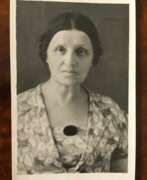

Lyudmila Davidovna Burliuk-Kuznetsova (Russian: Людмила Давидовна Бурлюк-Кузнецова) was a pivotal figure in the Russian avant-garde movement, born into a family renowned for its contribution to art and poetry. Her journey into the art world began with her studies at the Higher Art School of Painting, Sculpture, and Architecture at the Imperial Academy of Arts in St. Petersburg from 1903 to 1907. During her studies, she married Vasily Kuznetsov, a master of monumental and decorative sculpture, which marked the beginning of her active engagement with the Russian art scene. She was a vibrant participant in exhibitions across Russia, including those by the Association of Kharkov Artists, the Union of Russian Artists in St. Petersburg, and the art group "Wreath-Stefanos".
After a flourishing start, the mid-1910s saw Burliuk-Kuznetsova stepping back from her artistic endeavors to focus on her family. The tragic death of her husband in 1923 due to typhus left her to support their four children through her art, creating a diverse range of works from portraits to poster designs, even for the Saratov circus. Despite the personal hardships and the loss of two sons during World War II, her resilience and dedication to art never waned.
In her later years, she moved to Prague to live with her sister Marianna, where she rediscovered her passion for art and held a personal exhibition in 1967. Her work, deeply influenced by impressionism and particularly by the works of Paul Cezanne and Camille Pissarro, demonstrated her exceptional talent and her ability to capture the subtle interplay of light and atmosphere, conveying the magic of unpretentious natural motifs with grace and sensitivity.
For collectors and experts in art and antiques, Burliuk-Kuznetsova's story is not just one of artistic achievement but also of profound personal strength and perseverance. Her legacy is a testament to the vibrant spirit of the Russian avant-garde movement and its enduring influence on the art world.
To stay updated on artworks and auction events related to Lyudmila Davidovna Burliuk-Kuznetsova, consider signing up for updates. This subscription will ensure you're informed about new sales and exhibitions, keeping you connected to the legacy of this remarkable artist.


Eduard Adolf Daelen is a German artist, writer, and journalist.
He studied at the Düsseldorf Academy of Art and the Munich Academy of Fine Arts. Daelen was a member of the Malkasten Society of Artists (Malkasten) and was chairman of the local association Allgemeine Deutsche Kunstgenossenschaft. During World War I he took up drawing patriotic posters and war postcards.
Daelen also became known for the first biography of Wilhelm Busch, which he wrote in 1886. He also wrote art history articles that were published under pseudonyms in various newspapers.
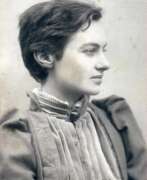

Mary Edith Durham was a British artist, anthropologist and writer who is best known for her anthropological accounts of life in Albania in the early 20th century. Her advocacy on behalf of the Albanian cause and her Albanophilia gained her the devotion of many Albanians who consider her a national heroine.
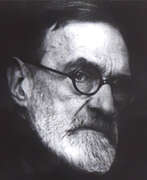

Pedro Figari was a Uruguayan painter, lawyer, writer, and politician. Although he did not begin the practice until his later years, he is best known as an early modernist painter who emphasized capturing the everyday aspects of life in his work. In most of his pieces, he attempts to capture the essence of his home by painting local customs that he had observed in his childhood.
Figari painted primarily from memory, a technique that gives his work a far more personal feeling. With his unique style, which involved painting without the intention to create an illusion, he, along with other prominent Latin-American artists such as Diego Rivera and Tarsila do Amaral, sparked a revolution of identity in the art world of Latin America.
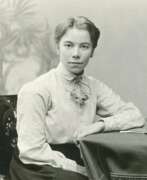

Elena Genrikhovna Guro (Russian: Еле́на Ге́нриховна Гуро́), born in 1877 in St. Petersburg, Russia, and passing in 1913, was a pioneering figure in the Russian Futurist movement. As a multifaceted artist, she delved into painting, writing, and poetry, marking her as a versatile and innovative force in the early 20th century Russian avant-garde. Guro's work is distinguished by its embrace of Futurism, a movement that sought to break away from traditional art forms and explore dynamic means of expression. Her contributions were not only limited to visual arts but also extended to literature, where she experimented with narrative forms and language, often incorporating nonsensical elements to challenge conventional aesthetics.
Guro's literary works, such as "The Little Camels of the Sky," demonstrate her experimental approach to language and form, embodying the Futurist fascination with the aesthetic possibilities of words. This approach is evident in her poetry and short stories, where she utilized single-word sentences and nonsense words to capture the essence of moments or convey a childlike perspective. Such techniques allowed her to explore the texture of language and its visual and auditory qualities, making her work resonate with the innovations of the Futurist and Dada movements.
Despite her early death at the age of 36, Guro's legacy continues to be celebrated for its contribution to the evolution of Russian modernism. Her work bridged the gap between the Symbolist movement and Futurism, contributing significantly to the dialogue around art and literature in her time. Her husband, Mikhail Matyushin, further propagated her artistic theories, ensuring that her innovative approach to color and form continued to influence Russian art and literature after her passing.
Elena Genrikhovna Guro remains an inspirational figure in the world of art and literature, embodying the spirit of innovation and exploration that defined the early 20th century avant-garde. Her works, which blend poetic language with vivid imagery, invite audiences to reconsider the boundaries between different art forms and the potential of language as an artistic medium.
For those intrigued by the rich tapestry of Russian Futurism and the unique voice of Elena Guro, signing up for updates on her works, sales, and auction events can deepen your appreciation and understanding of this pivotal artist's contributions. This subscription will ensure you stay informed about the latest insights and opportunities related to Elena Genrikhovna Guro's enduring legacy.
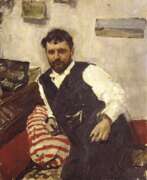

Konstantin Alekseyevich Korovin (Russian: Константи́н Алексе́евич Коро́вин) was a Russian artist and stage designer, renowned for his pivotal role in the transition from Russian Realism to Impressionism. Born in Moscow in 1861, Korovin's artistic journey began at the Moscow School of Painting, Sculpture, and Architecture, where he was heavily influenced by his mentor, Alexei Savrasov. His early work reflected the Realist tradition, but his style evolved after exposure to the vibrant art scenes of Paris and the influence of French Impressionists.
Korovin's contribution to art is marked by his vibrant palette and dynamic brushwork, capturing the transient effects of light and color with a spontaneity that was novel to Russian painting at the time. His works, ranging from lush landscapes and intimate still lifes to vivid portraits, showcase his mastery in evoking mood and atmosphere. Notably, his paintings of the Russian North and scenes of Parisian life have been celebrated for their lively, atmospheric qualities and are held in high esteem in museums and galleries worldwide, including the Tretyakov Gallery in Moscow and the Russian Museum in Saint Petersburg.
Beyond painting, Korovin's legacy includes significant contributions to theater design, where his innovative use of color and lighting brought new dimensions to stage productions in Russia, collaborating closely with the Moscow Art Theatre. His scenic designs for operas and ballets are credited with revolutionizing the visual aspect of Russian theater, making him a pivotal figure in both the visual and performing arts.
For collectors and experts in art and antiques, Korovin's works represent a unique blend of Russian tradition and Western artistic movements, making them highly sought after. His ability to capture the essence of a moment, whether in the tranquil Russian countryside or the bustling streets of Paris, continues to captivate audiences and scholars alike.
To stay informed on new sales and auction events featuring works by Konstantin Alekseyevich Korovin, sign up for our updates. This subscription ensures you're the first to know about valuable opportunities to add to your collection, focusing exclusively on Korovin's art and related events.


Arthur Karl Maderson is an Irish impressionist painter.
Arthur Maderson studied at Camberwell School of Art (London) and regularly exhibits at the Royal Academy and the Royal Hibernian Academy. In painting, Maderson uses the same principles as Claude Monet and other French Impressionists. He paints beach scenes, landscapes and figurative compositions.
The artist has also written numerous articles for magazines, as well as for the Encyclopedia of Oil Painting Techniques and other art history publications.


Jean Milo, real name Emile van Gindertael, is a Belgian writer, painter and gallery owner.
The artist's work reflects his evolution from refined impressionism to pure abstraction. Influenced by French Cubism, Milo simplified forms in still lifes and interiors, but continued to paint dynamic Impressionist interiors and cityscapes. Jean Milo was director of the Belgian gallery Le Centaure, and in 1952 he helped found the group Art abstrait.


Anna Petrovna Ostroumova-Lebedeva (Russian: Анна Петровна Остроумова-Лебедева) was a distinguished Russian and Soviet artist renowned for her contributions to watercolor painting and woodcut art. Her artistic journey was marked by innovation and a deep connection to her cultural roots. She is celebrated for pioneering the woodcut technique in Russia, bringing a unique vision to the portrayal of cityscapes, particularly those of Saint Petersburg.
Educated at the Stieglitz School of Technical Drawing and the Imperial Academy of Arts under the tutelage of Ilya Repin, Anna Ostroumova-Lebedeva was among the early female alumni of the academy, reflecting her pioneering spirit in the art world. Her study period in Paris at the Académie Colarossi and with James McNeill Whistler at the Académie Carmen further refined her skills, especially in graphics, which she majored in upon graduating in 1900. Her initial series of woodcuts in 1901, commissioned by Sergei Diaghilev, featured Saint Petersburg's cityscapes, establishing her affinity for capturing the essence of urban environments.
Throughout the 1900s and 1910s, her travels across Europe significantly influenced her work, as she also ventured into book illustration. Her career later transitioned into academia, where she served as a professor at the Leningrad Institute of Painting, Architecture, and Sculpture. Despite the adversities faced during the Siege of Leningrad and losing her sight later in life, she continued to inspire through her art and dedication.
Her works, such as "Summer Garden," a color woodcut from 1902, showcase her expertise in capturing the interplay of light, shadow, and nature, reflecting the serene beauty of Russian landscapes. Her pieces are not only artistic achievements but also historical documents that offer insight into the cultural and aesthetic sensibilities of her time.
For art collectors and enthusiasts, Anna Ostroumova-Lebedeva's works represent a profound connection to Russian art history, embodying the evolution of artistic techniques and the enduring charm of Saint Petersburg's cityscapes. Her legacy in watercolor and woodcut art remains a significant point of reference for those interested in the intersections of culture, history, and art.
If you're keen on delving deeper into the works and life of Anna Petrovna Ostroumova-Lebedeva and staying informed about relevant sales and auction events, consider signing up for updates. This way, you'll remain connected to the vibrant world of art and culture that she so beautifully represented.
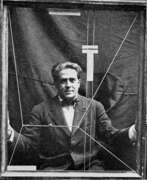

Francis Picabia, born Francis-Marie Martinez de Picabia, was a French avant-garde painter, poet, and typographist, whose work is celebrated for its diversity and innovation. His journey through various art movements, including Impressionism, Cubism, Dadaism, and Surrealism, showcases his refusal to be confined by any one style. Picabia's art is known for its eclectic nature, often blending mechanical elements with organic forms, thereby challenging traditional perceptions of art and beauty.
Picabia's significant contribution to the art world lies not just in his varied artistic output but also in his philosophical approach to creation. He believed in the freedom of expression, often using his art to critique societal norms and the art establishment itself. This rebellious spirit made him a pivotal figure in the Dada movement, where his works were celebrated for their irony and disdain for conventional art values.
Among his notable works, "Amorous Parade" and "I See Again in Memory My Dear Udnie" stand out, housed in prestigious institutions like the Museum of Modern Art in New York. These pieces exemplify Picabia's mastery over blending different elements of art movements, creating works that remain influential to this day. His legacy is not just in the pieces he created but also in his attitude towards art, encouraging future generations to challenge and redefine the boundaries of creativity.
For collectors and experts in art and antiques, Picabia's works represent not only significant artistic achievements but also valuable insights into the evolution of modern art. To stay informed about new product sales and auction events related to Francis Picabia, sign up for updates. This subscription is an essential resource for enthusiasts looking to enrich their collections with pieces from one of the most innovative artists of the 20th century.
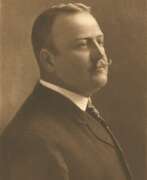

Frederic Sackrider Remington, an American artist born in 1861 in Canton, New York, is celebrated for his vivid portrayals of the American West. Specializing in painting, sculpture, and illustration, Remington captured the essence of Western life through dynamic scenes of cowboys, Native Americans, and the U.S. Cavalry, evoking a nostalgic era that was quickly vanishing by the late 19th century.
Remington's early experiences in the West, which included ventures into sheepherding and prospecting, profoundly influenced his artwork. Despite initial business failures and personal setbacks, his first-hand encounters with the rugged landscapes and frontier characters provided authentic material for his art. By the mid-1880s, Remington’s work began to gain recognition, and he quickly established himself as a significant figure in Western art, contributing illustrations to popular magazines like Harper’s Weekly.
In his later years, Remington's style evolved, displaying a notable shift towards impressionism and atmospheric mood in his "Nocturnes" series. These paintings are characterized by a dramatic use of light and shadow to convey the mystery and tension of nighttime in the West. Despite his own critical self-view, these works were highly regarded and marked a significant contribution to American art history. Remington’s art is featured in major collections, including the Metropolitan Museum of Art and the Frederic Remington Art Museum in Ogdensburg, New York, preserving his legacy as an icon of American culture.
For those interested in exploring more about Frederic Remington’s life and works, updates on exhibitions and sales can be subscribed to, keeping enthusiasts connected to new insights and offerings related to this influential artist.


Nadezhda Savelyevna Voitinskaya-Levidova (Russian: Надежда Савельевна Войтинская-Левидова) was a multifaceted Russian artist, writer, and translator, whose life spanned from 1886 to 1965. Born into a family with a strong academic background in St. Petersburg, she carved a unique path for herself in the arts and literature. Voitinskaya-Levidova was not only known for her artistic talents but also for her resilience and adaptability through challenging times, including her wrongful arrest in 1938 and survival during the siege of Leningrad in World War II.
Her journey into the arts began with painting lessons in private studios in St. Petersburg, followed by studies in painting and lithography in Paris. Voitinskaya-Levidova's return to Petersburg marked the beginning of a prolific period where she became closely associated with the "World of Art" artists. She made significant contributions through a series of lithographic portraits of famous writers of her time in 1909, demonstrating her skill and versatility in graphic arts. Her academic achievements included graduating from the Petrograd Institute of Art History in 1924, after which she dedicated herself to teaching and translating, enriching the cultural landscape with her translations of works by European authors and her own literary works.
The legacy of Nadezhda Savelyevna Voitinskaya-Levidova is preserved in the archives of Russia's National Library and her artworks, many of which are housed in prestigious collections such as the State Russian Museum, the Tretyakov Gallery, and the Pushkin Museum of Fine Arts. Her life and work stand as a testament to her enduring spirit and significant contributions to Russian art and literature.
For collectors and experts in art and antiques, the story of Nadezhda Savelyevna Voitinskaya-Levidova is a compelling narrative of creativity, resilience, and the power of cultural expression. Her contributions to art and literature continue to inspire and resonate with audiences, underscoring the importance of preserving and celebrating her legacy.
To stay updated on exhibitions and sales related to Nadezhda Savelyevna Voitinskaya-Levidova's work, consider signing up for updates. This subscription ensures you're informed about new product sales and auction events specifically related to her oeuvre, connecting you directly with the rich history and enduring impact of her contributions to art and culture.


Sophie von Adelung (Russian: Софья Николаевна фон Аделунг) was a German writer and artist of late nineteenth and early twentieth century Russian descent. She wrote literary works, addressed mainly to young people, and often illustrated them herself.
Sophie von Adelung also published short stories translated from Russian into German. As a staff member, she wrote regularly for the magazines Die Fraurude, Fürs Haus, and Töchter-Album.
